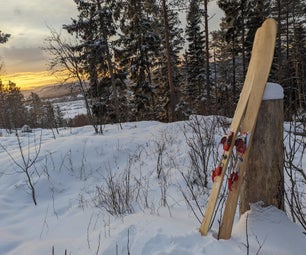Introduction: How to Survive Snowboarding in Canada
this will be an ible of all the things i have learned about staying warm while snowboarding most tips can be applied to skiing as well. i say how to stay warm in canada because i have never needed to use any of these tactics in any other place, the coldest i have ever been is on a ski lift in canada. all of these pictures have been taken by me, of a thing that i drew rather accurately not to pat myself on the back.
Step 1: Materials
i will be more specific in the following steps.
-snow jacket
-snow pants
-long underwear
-underwear
-tee shirt
-turtle neck (if you can stand them)
-thin beanie
-thick socks
-scarf/neck warmer
-fleece or hoodie
-thin gloves
-mittens
-helmet (safety first)
-googles
-wrist guards (#1 snowboarding injury is broken wrist)
-knee pads (highly recommended for beginners)
-snowboard boots
-long sleeve shirt
Step 2: Snow Jacket and Pants
you want a high waterproof rating and a high breathability. high waterproof rating to keep you dry. a high breathability to prevent over heating. an example of these ratings are:
Waterproof Rating:
10K
Breathable Rating:
10000g
this is a good rating for a jacket, snowboarding pants should have a higher waterproof rating.
like.Waterproof Rating:
15K
Breathable Rating:
10000g
these will keep you dry even after you fall a bunch on your butt. another feature that is beneficial are taped seam and powder skirts (also referred to as waist gaiters). ankel gaiters are a necessity also.
Step 3: Under Garments
Up High:
a cotton t-shirt should be worn as a base. a turtle neck or regular long sleeve shirt of your choice worn as a 2nd layer (if you cant stand turtle necks). main insulating layer can be a fleece or hoodie, i prefer hoodies because i find them more comfortable, and way cooler.
Down Low:
fleece long underwear is the warmest and best for very cold weather.
(i recommend not wearing boxers as they get all f*d up under long under wear)
Too Slow:
a neck warmer or scarf is very important also. do not use the full face things as they become wet from your breath and will freeze to your face.
Step 4: Hats, Socks, and Mittens
Hats:
you should wear a thin beanie so it will fit under your helmet that you need for safety.
Socks:
socks you should be socks designed for snowboarding as they are thick, padded and longer to prevent pain caused by boots.
mittens:
thin gloves with some mittens on top is the warmest solution. your mittens should be gortex if you snowboard, as you probably touch the snow more then those on skis. if you find mittens are to hard to adjust your bindings with, then you can try grenade glove/mittens that are called DK trigger happy gloves.
Step 5: Protection
use protection, and no i dont mean condoms but you should use those too.
Helmet:
it should really be a helmet designed for skiing and/or snowboarding.
if you cant get a skiing and/or snowboarding helmet then rent one at the ski rental shop, if they dont rent them use a skateboard or bmx helmet, its not as good but a helmet of any sorts is better then nothing.
*Replace your helmet after every crash that results in a concussion, every 5 years, or when the manufacturer suggests*
Wrist guards:
they really are necessary broken, fractured, or sprained wrists are the number1 snowboarding injury.
(my brother broke his wrist doing a simple 180 of the ground in the winter of 2011)
knee pads:
these aren't necessary but i wish i had them when i was a beginner.
my girlfriend swears by volley ball knee pads, but skating ones will work just fine.
googles:
it is very hard to tell what googles are good without trying them so i go by brand, not to say there arent any other good ones but i know i can rely on these. the best brands are anon, scott, electric, smith and Oakley. if your favorite brand isnt here leave it in the comments for others to see. also if you wear glasses for distance you must keep them on even if it makes you look dumb (or you can get contacts like me.)
Step 6: "the Board" and Other Things
ill keep it simple and sweat as anyone who knows enough about boards to buy one can choose on their own without this ible.
Board:
if you own your own board you need to make sure your board is good on ice. if you dont own one then the rental shop should be able to get one set up for you.
Boots:
make sure your boots are tight but not too tight to ensure they are not too tight wear you ski socks when you go to try them on.
googles:
it is very hard to tell what googles are good without trying them so i go by brand, not to say there arent any other good ones but i know i can rely on these. the best brands are anon, scott, electric, smith and Oakley. if your favorite brand isnt here leave it in the comments for others to see. also if you wear glasses for distance you must keep them on even if it makes you look dumb (or you can get contacts like me.)









